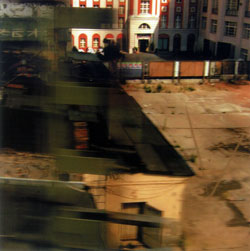
In the realm of improvised electronica these days, those with the widest palettes tend to have an easier time. DJs, lap-toppers, and synthesists, for example, can have almost instant access to the full range of rhythms, samples, timbres, etc., and can easily layer them and manipulate them in real time. In light of this space of possibilities, traditional instruments may seem almost quaint by comparison. For a guitarist like Andy Moor, who mostly uses a relatively straightforward axe-and-amp attack, a duo with a DJ known for his complex mixes could be something of a proving ground.
DJ /rupture, AKA Jace Clayton, made perhaps his biggest splash so far with 2002's Minesweeper Suite, which The Wire called one of the year's ten best records. His ear for complicated orchestration of source materials is huge, and his spontaneous compositions often skillfully walk the thin line between the symphonic and the chaotic. Andy Moor, meanwhile, is perhaps best known as a member of the long-standing Dutch punk band The Ex. In recent years Moor has established a rep in the avant world in outings with folks like Ken Vandermark, Mia Clarke of Electrelane, Yannis Kyriakides, and Paal Nilssen-Love.
Although the music is described in the liner notes as "spontaneous, improvised live during shows across Europe", the tightness of the pieces at times defies the expectations of such a description. The almost seamless sectional transitions in "hot pink orleans" are a fine example, and is a stunning mixture of sound textures and a perfectly-chosen dubstep-ish backdrop. Moor's guitar — perfectly mixed with /rupture's contributions — wends its way into the soundscape with immaculate timing, alternating between pseudo-Asian twang and resonant Sonic-Youth-like chords.
While /rupture often sets the sonic stage with sample beats, Moor occasionally lays down the initial rhythms. On "ella speed" Moor initially plinks and plonks a repeated atonal figure on guitar. It takes a few moments, but /rupture manages to select a perfectly complementary sample beat with Moving Ninja's "Uranium." And on "the sheep look up", a Moor intro leads to another uncanny instance in which the music perfectly coalesces. Moor apparently establishes the direction the song will take by playing a clear rhythmic riff, repeating it for several bars. /rupture essentially lays out during this segment, playing only sounds akin to tapes rewinding, then suddenly fades-in the instrumental track from Timbaland's "Give it to me." The beat perfectly fits Moor's jaunty riff, and the guitarist only has to slightly alter his rhythm for the two to land in perfect sync. It is a stunning bit of improvised DJing on /rupture's part, all the more so if there was no pre-planning at all involved.
Other pieces, however, do have a more on-the-fly feel to them. On the second track the backbeat sampled from Timeblind comes in strong at the start, and the layers of additional sounds settle into the mix more loosely. Similarly, the atmospherics of the samples on "chisanga" and the loping rhythm provide lots of space for trying out various approaches. Moor takes advantage of this opportunity nicely, starting with watery glissandos and working his way to some tasteful rhythmic chugging. Only one track stands out as leaning toward the fears of awkwardness that a DJ/guitar duo engenders. On "is it goin," /rupture reprises the Timbaland instrumental track from "the sheep look up," this time not doing much along with it. Moor sounds rather naked in the mix as he plucks along rhythmically, sometimes missing changes in the beats. The result is a bit too close to St. Sanders' "Shreds" videos, or is redolent of a guitarist noodling along with the radio at home.
Overall, though, the outing is highly successful. There are pieces here that get a bit stuck in one's head, begging for repeated listening, which is something of an achievement for improvised music. /rupture also sets up quite a bit of fun by meticulously listing in the liner notes what samples he is using, allowing the listener to easily find the originals online and doing a bit of comparative listening. I hope to hear much more from these two.
Comments and Feedback:



More Recent Reviews, Articles, and Interviews @ The Squid's Ear...


|

